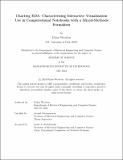Charting EDA: Characterizing Interactive Visualization Use in Computational Notebooks with a Mixed-Methods Formalism
Author(s)
Wootton, Dylan
DownloadThesis PDF (1.746Mb)
Advisor
Satyanarayan, Arvind
Terms of use
Metadata
Show full item recordAbstract
Interactive visualizations are powerful tools for Exploratory Data Analysis (EDA), but how do they affect the observations analysts make about their data? We conducted a qualitative experiment with 13 professional data scientists analyzing two datasets with Jupyter notebooks, collecting a rich dataset of interaction traces and think-aloud utterances. By qualitatively coding participant utterances, we introduce a formalism that describes EDA as a sequence of analysis states, where each state is comprised of either a representation an analyst constructed (e.g., the output of a data frame, an interactive visualization, etc.) or an observation the analyst made with a representation (e.g., about missing data, the relationship between variables, etc.). By applying our formalism to our dataset, we are able to identify that interactive visualizations, on average, lead to earlier and more complex insights about relationships between dataset attributes compared to static visualizations. Moreover, by calculating metrics such as revisiting count and representational diversity, we are able to uncover that some representations serve more as as "planning aids" during EDA rather than tools strictly for hypothesis-answering.
We show how these measures helped identify other patterns of analysis behavior, such as the "80-20 rule", where a small subset of representations drove the majority of observations. Based on these findings, we offer design guidelines for interactive exploratory analysis tooling and reflect on future directions for studying the role that visualizations play in EDA.
Date issued
2024-05Department
Massachusetts Institute of Technology. Department of Electrical Engineering and Computer SciencePublisher
Massachusetts Institute of Technology